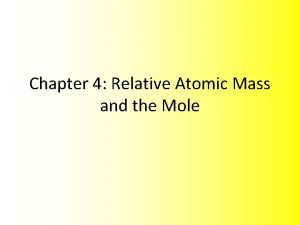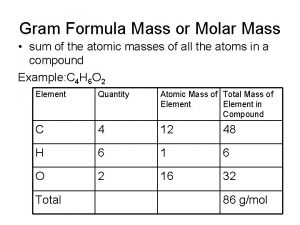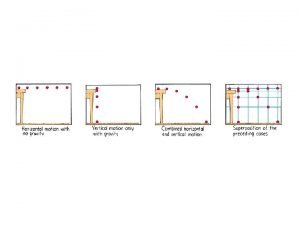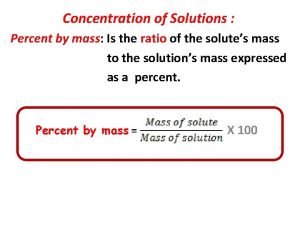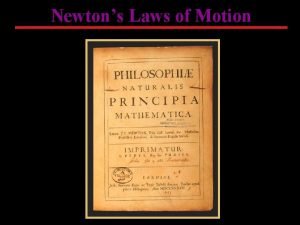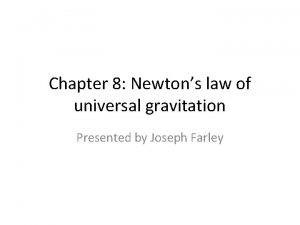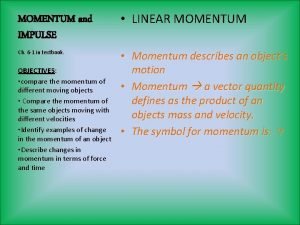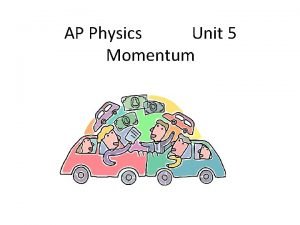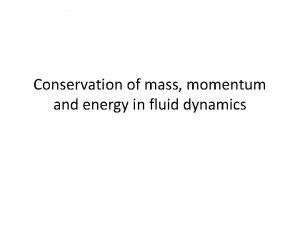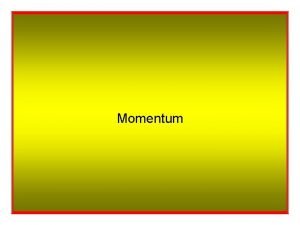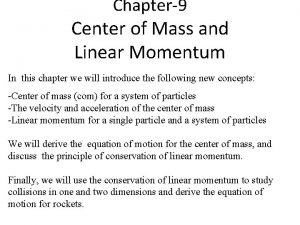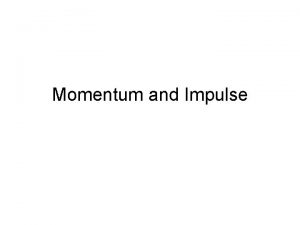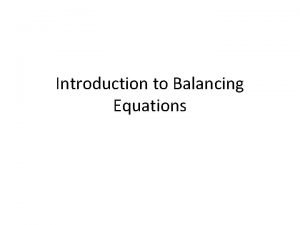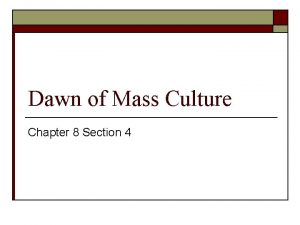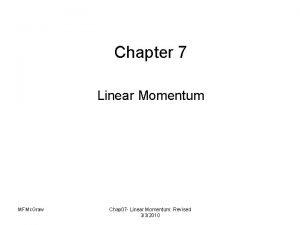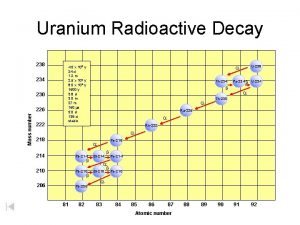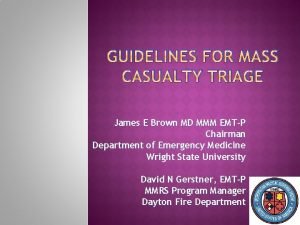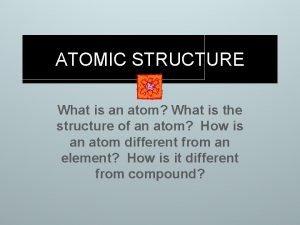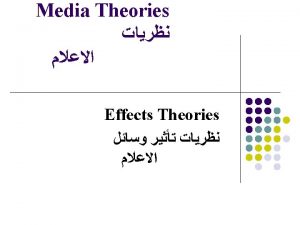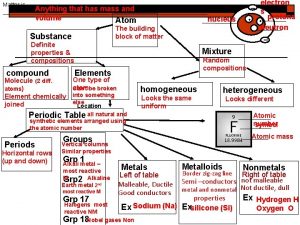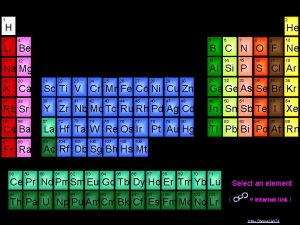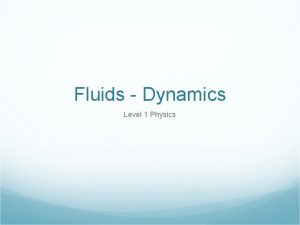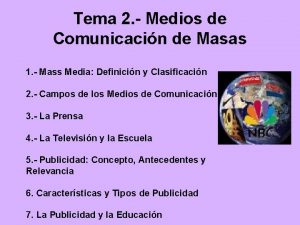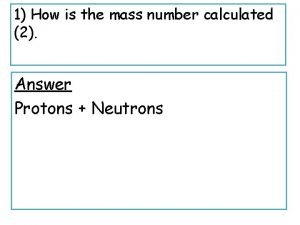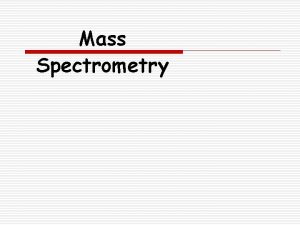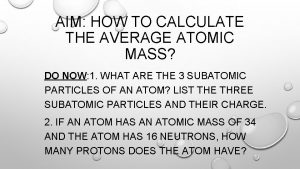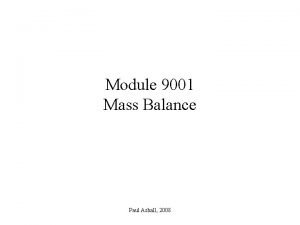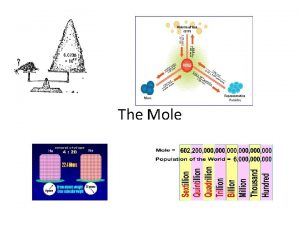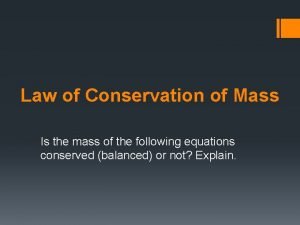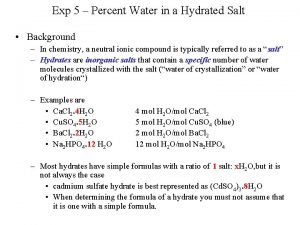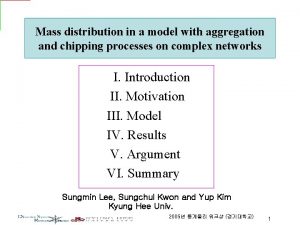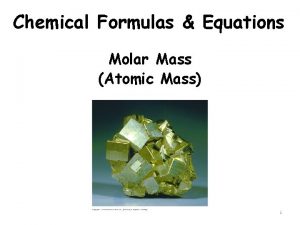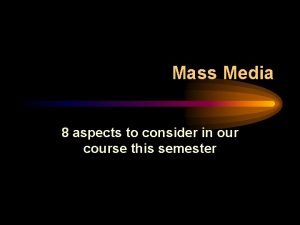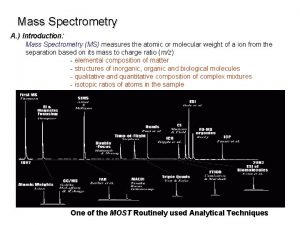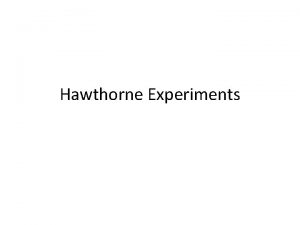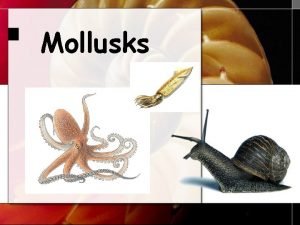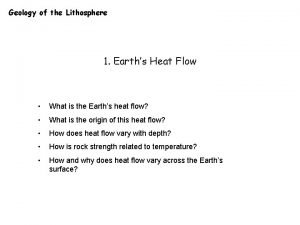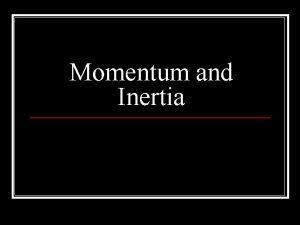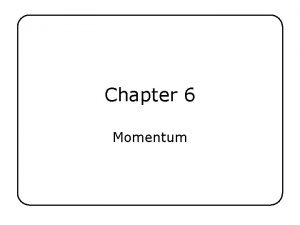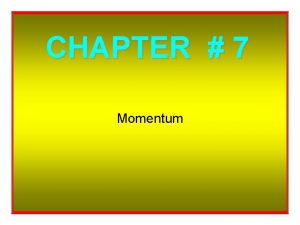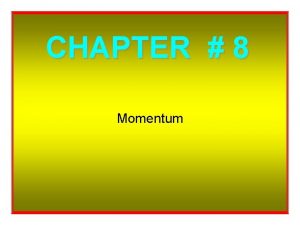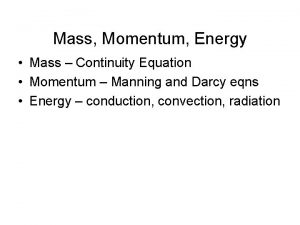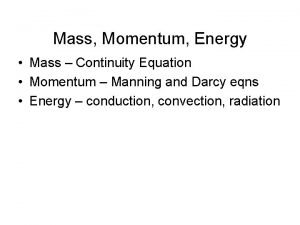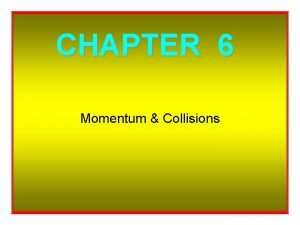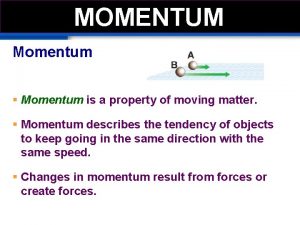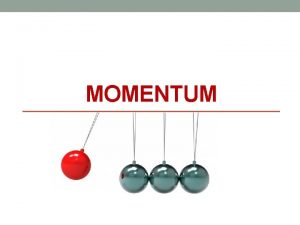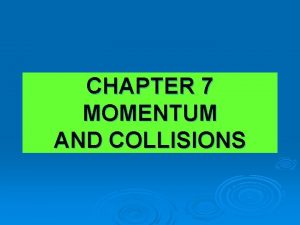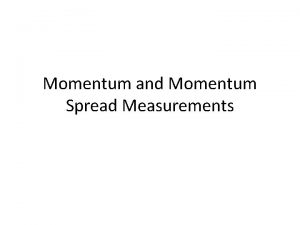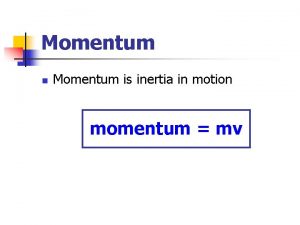8 Momentum 8 1 Momentum mass in Momentum


























































































- Slides: 90

8 Momentum 8. 1 Momentum – mass in _______! Momentum is the mass of an object multiplied by its velocity. momentum = ____ x ______ Momentum (__) = mv

8 Momentum 8. 1 Momentum A truck rolling down a hill has more momentum than a roller skate with the same speed. But if the truck is at rest and the roller skate moves, then the skate has more momentum.

8 Momentum 8. 1 Momentum think! Can you think of a case where a roller skate and a truck would have the same momentum?

8 Momentum 8. 1 Momentum think! Can you think of a case where a roller skate and a truck would have the same momentum? Answer: The roller skate and truck can have the same momentum if the speed of the roller skate is much greater than the speed of the truck. For example, a 1000 -kg truck backing out of a driveway at 0. 01 m/s has the same momentum as a 1 -kg skate going 10 m/s. Both have momentum = 10 kg • m/s.

8 Momentum What is the momentum of a 180 lb running back with a velocity of 5. 0 m/s? A. 900 kg. m/s B. 1200 kg. m/s C. 410 kg. m/s D. 180 kg. m/s

8 Momentum Which object would have the greatest momentum? A. A 30 kg bike traveling at 5 m/s B. A 70 kg student jogging at 1 m/s C. A 0. 001 kg bullet traveling at 300 m/s D. a 10 kg ball falling at 2 m/s

8 Momentum If an object decreases its speed by half, what will happen to it’s momentum? A. It will not change. B. It will double. C. It will decrease by half. D. It depends on its mass.

8 Momentum 8. 2 Impulse Changes Momentum Impulse A force sustained for a long time produces more change in momentum than does the same force applied briefly. Both force and time are important in changing an object’s momentum.

8 Momentum • • Newton’s 2 nd Law: Original Form F=mxa F= mΔv (Note: a = Δv/Δt) Δt • Rearranging produces, = Impulse An impulse will cause a change in momentum. Momentum

8 Momentum 8. 2 Impulse Changes Momentum When you push with the same force for twice the time, you impart twice the impulse and produce twice the change in momentum.

8 Momentum 8. 2 Impulse Changes Momentum If the change in momentum occurs over a long time, the force of impact is small.

8 Momentum 8. 2 Impulse Changes Momentum If the change in momentum occurs over a short time, the force of impact is large.

8 Momentum 8. 2 Impulse Changes Momentum When hitting either the wall or the haystack and coming to a stop, the momentum is decreased by the same impulse. • The same impulse does not mean the same amount of force or the same amount of time. • It means the same product of force and time. • To keep the force small, we extend the time.

8 Momentum 8. 2 Impulse Changes Momentum think! If a boxer is able to make the contact time five times longer by “riding” with the punch, how much will the force of the punch impact be reduced?

8 Momentum 8. 2 Impulse Changes Momentum think! If a boxer is able to make the contact time five times longer by “riding” with the punch, how much will the force of the punch impact be reduced? Answer: Since the time of impact increases five times, the force of impact will be reduced five times.

8 Momentum Increasing Contact Time When There’s a Constant Force: t Δv F =m • When force and mass are constant, – i. e. - the mass of the ball is fixed and you’re hitting it with as much force as possible • how can you increase the distance of the hit object? “Follow Through”

8 Momentum Reducing Impact Force t = m Δv F • When momentum is constant, – i. e. - the mass and speed of the object are fixed • how can you decrease the force felt on impact?

8 Momentum Impulse/Momentum and Automobile Collisions • Purpose of car crumple zones, seatbelts and airbags is to _____ contact time and thereby _______ force • Three collisions in every accident – _________________________ – _____________ • In a 30 mph accident, a 15 lb child can generate 300 lbs of force.

8 Momentum Ft = mΔv Situation #1 Driver A, mass 75 kg, is traveling at 40. 0 mph (17. 9 m/s) when the car strikes a pole. The driver is not wearing a seatbelt and there is no airbag. If the driver hits the steering wheel and comes to a stop in 0. 012 seconds, what impact force does the driver feel? A. -16 N B. -112 N C. -112, 000 N D. -250, 000 N

8 Momentum Situation #1 25, 000 lbs of force! (152 g’s of deceleration)

8 Momentum Ft = mΔv Situation #2 Driver B, mass 75 kg, is traveling at 40. 0 mph (17. 9 m/s) when the car strikes a pole. The driver is belted and the car is equipped with an airbag. If the driver impacts the airbag and comes to a stop in 0. 11 seconds, what impact force does the driver feel? A. 150 N B. 12, 000 N C. -12, 000 N D. -27, 000 N

8 Momentum Situation #2 2740 lbs of force. (16. 6 g’s of deceleration)

8 Momentum Crash Test Dummies Video: Understanding Car Crashes http: //tinyurl. com/crashtestvideo

8 Momentum Crash Test Simulator http: //tinyurl. com/crashtestsim

8 Momentum 8. 2 Impulse Changes Momentum What factors affect how much an object’s momentum changes?

8 Momentum 8. 3 Bouncing The impulse required to bring an object to a stop and then to “throw it back again” is greater than the impulse required merely to bring the object to a stop.

8 Momentum 8. 3 Bouncing Suppose you catch a falling pot with your hands. • You provide an impulse to reduce its momentum to zero. • If you throw the pot upward again, you have to provide additional impulse.

8 Momentum 8. 3 Bouncing If the flower pot falls from a shelf onto your head, you may be in trouble. If it bounces from your head, you may be in more serious trouble because impulses are greater when an object bounces. The increased impulse is supplied by your head if the pot bounces.

8 Momentum 8. 3 Bouncing Cassy imparts a large impulse to the bricks in a short time and produces considerable force. Her hand bounces back, yielding as much as twice the impulse to the bricks.

8 Momentum 8. 3 Bouncing The block topples when the swinging dart bounces from it. Without the rubber head of the dart, it doesn’t bounce when it hits the block and no toppling occurs.

8 Momentum 8. 3 Bouncing The waterwheels used in gold mining operations during the California Gold Rush were not very effective. Lester A. Pelton designed a curve-shaped paddle that caused the incoming water to make a U-turn upon impact. The water “bounced, ” increasing the impulse exerted on the waterwheel.

8 Momentum 8. 3 Bouncing The curved blades of the Pelton Wheel cause water to bounce and make a U-turn, producing a large impulse that turns the wheel.

8 Momentum 8. 3 Bouncing How does the impulse of a bounce compare to stopping only?

8 Momentum 8. 4 Conservation of Momentum The law of conservation of momentum states that, in the absence of an external force, the momentum of a system remains unchanged.

8 Momentum 8. 4 Conservation of Momentum The force or impulse that changes momentum must be exerted on the object by something outside the object. • Molecular forces within a basketball have no effect on the momentum of the basketball. • A push against the dashboard from inside does not affect the momentum of a car. These are internal forces. They come in balanced pairs that cancel within the object.

8 Momentum 8. 4 Conservation of Momentum The momentum before firing is zero. After firing, the net momentum is still zero because the momentum of the cannon is equal and opposite to the momentum of the cannonball.

8 Momentum 8. 4 Conservation of Momentum The force on the cannonball inside the cannon barrel is equal and opposite to the force causing the cannon to recoil. The action and reaction forces are internal to the system so they don’t change the momentum of the cannon-cannonball system. • Before the firing, the momentum is zero. • After the firing, the net momentum is still zero. • Net momentum is neither gained nor lost.

8 Momentum 8. 4 Conservation of Momentum has both direction and magnitude. It is a vector quantity. • The cannonball gains momentum and the recoiling cannon gains momentum in the opposite direction. • The cannon-cannonball system gains none. • The momenta of the cannonball and the cannon are equal in magnitude and opposite in direction. • No net force acts on the system so there is no net impulse on the system and there is no net change in the momentum.

8 Momentum 8. 4 Conservation of Momentum In every case, the momentum of a system cannot change unless it is acted on by external forces. When any quantity in physics does not change, we say it is conserved.

8 Momentum 8. 4 Conservation of Momentum The law of conservation of momentum describes the momentum of a system: If a system undergoes changes wherein all forces are internal, the net momentum of the system before and after the event is the same. Examples are: • atomic nuclei undergoing radioactive decay, • cars colliding, and • stars exploding.

8 Momentum 8. 4 Conservation of Momentum think! Newton’s second law states that if no net force is exerted on a system, no acceleration occurs. Does it follow that no change in momentum occurs?

8 Momentum 8. 4 Conservation of Momentum think! Newton’s second law states that if no net force is exerted on a system, no acceleration occurs. Does it follow that no change in momentum occurs? Answer: Yes, because no acceleration means that no change occurs in velocity or in momentum (mass × velocity). Another line of reasoning is simply that no net force means there is no net impulse and thus no change in momentum.

8 Momentum 8. 4 Conservation of Momentum What does the law of conservation of momentum state?

8 Momentum 8. 5 Collisions Whenever objects collide in the absence of external forces, the net momentum of the objects before the collision equals the net momentum of the objects after the collision.

8 Momentum 8. 5 Collisions The collision of objects clearly shows the conservation of momentum.

8 Momentum 8. 5 Collisions Elastic Collisions When a moving billiard ball collides head-on with a ball at rest, the first ball comes to rest and the second ball moves away with a velocity equal to the initial velocity of the first ball. Momentum is transferred from the first ball to the second ball.

8 Momentum 8. 5 Collisions When objects collide without being permanently deformed and without generating heat, the collision is an elastic collision. Colliding objects bounce perfectly in perfect elastic collisions. The sum of the momentum vectors is the same before and after each collision.

8 Momentum 8. 5 Collisions a. A moving ball strikes a ball at rest.

8 Momentum 8. 5 Collisions a. A moving ball strikes a ball at rest. b. Two moving balls collide head-on.

8 Momentum 8. 5 Collisions a. A moving ball strikes a ball at rest. b. Two moving balls collide head-on. c. Two balls moving in the same direction collide.

8 Momentum 8. 5 Collisions Inelastic Collisions A collision in which the colliding objects become distorted and generate heat during the collision is an inelastic collision. Momentum conservation holds true even in inelastic collisions. Whenever colliding objects become tangled or couple together, a totally inelastic collision occurs.

8 Momentum 8. 5 Collisions In an inelastic collision between two freight cars, the momentum of the freight car on the left is shared with the freight car on the right.

8 Momentum 8. 5 Collisions The freight cars are of equal mass m, and one car moves at 4 m/s toward the other car that is at rest. net momentum before collision = net momentum after collision (net mv)before = (net mv)after (m)(4 m/s) + (m)(0 m/s) = (2 m)(vafter)

8 Momentum 8. 5 Collisions Twice as much mass is moving after the collision, so the velocity, vafter, must be one half of 4 m/s. vafter = 2 m/s in the same direction as the velocity before the collision, vbefore.

8 Momentum 8. 5 Collisions The initial momentum is shared by both cars without loss or gain. Momentum is conserved. External forces are usually negligible during the collision, so the net momentum does not change during collision.

8 Momentum 8. 5 Collisions External forces may have an effect after the collision: • Billiard balls encounter friction with the table and the air. • After a collision of two trucks, the combined wreck slides along the pavement and friction decreases its momentum. • Two space vehicles docking in orbit have the same net momentum just before and just after contact. Since there is no air resistance in space, the combined momentum is then changed only by gravity.

8 Momentum 8. 5 Collisions Perfectly elastic collisions are not common in the everyday world. Drop a ball and after it bounces from the floor, both the ball and the floor are a bit warmer. At the microscopic level, however, perfectly elastic collisions are commonplace. For example, electrically charged particles bounce off one another without generating heat; they don’t even touch in the classic sense of the word.

8 Momentum 8. 5 Collisions An air track nicely demonstrates conservation of momentum. Many small air jets provide a nearly frictionless cushion of air for the gliders to slide on.

8 Momentum 8. 5 Collisions think! One glider is loaded so it has three times the mass of another glider. The loaded glider is initially at rest. The unloaded glider collides with the loaded glider and the two gliders stick together. Describe the motion of the gliders after the collision.

8 Momentum 8. 5 Collisions think! One glider is loaded so it has three times the mass of another glider. The loaded glider is initially at rest. The unloaded glider collides with the loaded glider and the two gliders stick together. Describe the motion of the gliders after the collision. Answer: The mass of the stuck-together gliders is four times that of the unloaded glider. The velocity of the stuck-together gliders is one fourth of the unloaded glider’s velocity before collision. This velocity is in the same direction as before, since the direction as well as the amount of momentum is conserved.

8 Momentum 8. 5 Collisions do the math! Consider a 6 -kg fish that swims toward and swallows a 2 -kg fish that is at rest. If the larger fish swims at 1 m/s, what is its velocity immediately after lunch?

8 Momentum 8. 5 Collisions do the math! Consider a 6 -kg fish that swims toward and swallows a 2 -kg fish that is at rest. If the larger fish swims at 1 m/s, what is its velocity immediately after lunch? Momentum is conserved from the instant before lunch until the instant after (in so brief an interval, water resistance does not have time to change the momentum).

8 Momentum 8. 5 Collisions do the math!

8 Momentum 8. 5 Collisions do the math! Suppose the small fish is not at rest but is swimming toward the large fish at 2 m/s.

8 Momentum 8. 5 Collisions do the math! Suppose the small fish is not at rest but is swimming toward the large fish at 2 m/s. If we consider the direction of the large fish as positive, then the velocity of the small fish is – 2 m/s.

8 Momentum 8. 5 Collisions do the math! The negative momentum of the small fish slows the large fish.

8 Momentum 8. 5 Collisions do the math! If the small fish were swimming at – 3 m/s, then both fish would have equal and opposite momenta. Zero momentum before lunch would equal zero momentum after lunch, and both fish would come to a halt.

8 Momentum 8. 5 Collisions do the math! Suppose the small fish swims at – 4 m/s. The minus sign tells us that after lunch the two-fish system moves in a direction opposite to the large fish’s direction before lunch.

8 Momentum 8. 5 Collisions How does conservation of momentum apply to collisions?

8 Momentum 8. 6 Momentum Vectors The vector sum of the momenta is the same before and after a collision.

8 Momentum 8. 6 Momentum Vectors Momentum is conserved even when interacting objects don’t move along the same straight line. To analyze momentum in any direction, we use the vector techniques we’ve previously learned. We’ll look at momentum conservation involving angles by considering three examples.

8 Momentum 8. 6 Momentum Vectors Momentum is a vector quantity. The momentum of the wreck is equal to the vector sum of the momenta of car A and car B before the collision.

8 Momentum 8. 6 Momentum Vectors The momentum of car A is directed due east and that of car B is directed due north. If their momenta are equal in magnitude, after colliding their combined momentum will be in a northeast direction with a magnitude times the momentum either vehicle had before the collision.

8 Momentum 8. 6 Momentum Vectors When the firecracker bursts, the vector sum of the momenta of its fragments add up to the firecracker’s momentum just before bursting.

8 Momentum 8. 6 Momentum Vectors A falling firecracker explodes into two pieces. The momenta of the fragments combine by vector rules to equal the original momentum of the falling firecracker.

8 Momentum 8. 6 Momentum Vectors Momentum is conserved for the high-speed elementary particles, as shown by the tracks they leave in a bubble chamber.

8 Momentum 8. 6 Momentum Vectors Subatomic particles make tracks in a bubble chamber. The mass of these particles can be computed by applying both the conservation of momentum and conservation of energy laws. The conservation laws are extremely useful to experimenters in the atomic and subatomic realms.

8 Momentum 8. 6 Momentum Vectors What is true about the vector sum of momenta in a collision?

8 Momentum Assessment Questions 1. When the speed of an object is doubled, its momentum a. remains unchanged in accord with the conservation of momentum. b. doubles. c. quadruples. d. decreases.

8 Momentum Assessment Questions 1. When the speed of an object is doubled, its momentum a. remains unchanged in accord with the conservation of momentum. b. doubles. c. quadruples. d. decreases. Answer: B

8 Momentum Assessment Questions 2. The impulse-momentum relationship is a direct result of Newton’s a. first law. b. second law. c. third law. d. law of gravity.

8 Momentum Assessment Questions 2. The impulse-momentum relationship is a direct result of Newton’s a. first law. b. second law. c. third law. d. law of gravity. Answer: B

8 Momentum Assessment Questions 3. When a falling object bounces, as it hits the ground its change in momentum and the impulse on it is a. less than for stopping. b. greater than for stopping. c. the same as it is for stopping. d. the same as it was when dropped.

8 Momentum Assessment Questions 3. When a falling object bounces, as it hits the ground its change in momentum and the impulse on it is a. less than for stopping. b. greater than for stopping. c. the same as it is for stopping. d. the same as it was when dropped. Answer: B

8 Momentum Assessment Questions 4. On roller blades you horizontally toss a ball away from you. The mass of the ball is one tenth your mass. Compared with the speed you give to the ball, your recoil speed will ideally be a. one tenth as much. b. the same. c. ten times as much. d. 100 times as much.

8 Momentum Assessment Questions 4. On roller blades you horizontally toss a ball away from you. The mass of the ball is one tenth your mass. Compared with the speed you give to the ball, your recoil speed will ideally be a. one tenth as much. b. the same. c. ten times as much. d. 100 times as much. Answer: A

8 Momentum Assessment Questions 5. A big fish swims upon and swallows a small fish at rest. After lunch, the big fish has less a. speed. b. momentum. c. both of these d. none of these

8 Momentum Assessment Questions 5. A big fish swims upon and swallows a small fish at rest. After lunch, the big fish has less a. speed. b. momentum. c. both of these d. none of these Answer: A

8 Momentum Assessment Questions 6. A falling firecracker bursts into two pieces. Compared with the momentum of the firecracker when it bursts, the two pieces a. combined have the same momentum. b. each have half as much momentum. c. have more momentum. d. may or may not have more momentum.

8 Momentum Assessment Questions 6. A falling firecracker bursts into two pieces. Compared with the momentum of the firecracker when it bursts, the two pieces a. combined have the same momentum. b. each have half as much momentum. c. have more momentum. d. may or may not have more momentum. Answer: A
 Formula mass vs gram formula mass
Formula mass vs gram formula mass Formula mass vs molecular mass
Formula mass vs molecular mass Molality formula
Molality formula Is atomic mass and relative atomic mass the same
Is atomic mass and relative atomic mass the same Does an iron nail gain mass or lose mass when it rusts
Does an iron nail gain mass or lose mass when it rusts Formula mass
Formula mass Mass number formula
Mass number formula How to convert moles to grams
How to convert moles to grams Cold air mass overtakes warm air mass
Cold air mass overtakes warm air mass Is atomic mass and relative atomic mass the same
Is atomic mass and relative atomic mass the same Mass/mass problems
Mass/mass problems How to find mass percent
How to find mass percent A rocket of mass 12000 kg accelerates vertically
A rocket of mass 12000 kg accelerates vertically Mass to mass percent
Mass to mass percent Molecular mass
Molecular mass Molar mass unit
Molar mass unit Stoichiometry mass to mass formula
Stoichiometry mass to mass formula Atomic mass vs molar mass
Atomic mass vs molar mass Difference between atomic number and atomic mass
Difference between atomic number and atomic mass Inertial mass vs gravitational mass
Inertial mass vs gravitational mass Mass mole
Mass mole Inertial mass vs gravitational mass
Inertial mass vs gravitational mass How to convert grams to moles
How to convert grams to moles Mass number vs atomic mass
Mass number vs atomic mass Stoichiometry worksheet #2 (mole-mass mass-mole problems)
Stoichiometry worksheet #2 (mole-mass mass-mole problems) Gravitational mass vs inertial mass
Gravitational mass vs inertial mass What is atomicity
What is atomicity Mole ratio
Mole ratio Which has a greater momentum a truck with a mass of 2250 kg
Which has a greater momentum a truck with a mass of 2250 kg Conservation of mass momentum and energy equations
Conservation of mass momentum and energy equations Mass times velocity
Mass times velocity Ap physics 1 unit 5
Ap physics 1 unit 5 Fluid
Fluid Momentum = mass x
Momentum = mass x Momentum=mass x velocity
Momentum=mass x velocity Center of mass and linear momentum
Center of mass and linear momentum Momentum formula in terms of energy
Momentum formula in terms of energy Conceptual physics momentum
Conceptual physics momentum Lesson 2 the emergence of mass society
Lesson 2 the emergence of mass society Example of law of conservation of mass
Example of law of conservation of mass The dawn of mass culture section 4
The dawn of mass culture section 4 Air mass vocabulary
Air mass vocabulary Mass customized learning
Mass customized learning Define momentum
Define momentum Star with small and medium mass
Star with small and medium mass Is lead radioactive
Is lead radioactive State law of mass action
State law of mass action Mass casualty triage guidelines
Mass casualty triage guidelines Mass of neutron
Mass of neutron 5 elements of mass communication
5 elements of mass communication Anything that has mass and volume
Anything that has mass and volume Al atomic mass
Al atomic mass Mass of fluid
Mass of fluid Medio de comunicación de masas
Medio de comunicación de masas Chapter 8 section 3 the mass media
Chapter 8 section 3 the mass media Mass conservation equation
Mass conservation equation Fission and fusion similarities
Fission and fusion similarities What is visceral mass in molluscs
What is visceral mass in molluscs Mass versus weight
Mass versus weight Three rods each of area 250mm
Three rods each of area 250mm Mass number 25
Mass number 25 Sdbsweb
Sdbsweb Atomic mass cl
Atomic mass cl How to find avg atomic mass
How to find avg atomic mass Mass balancing module
Mass balancing module Software consists of
Software consists of Mass media movies
Mass media movies Mole to mass
Mole to mass State the law of conservation of mass
State the law of conservation of mass Experiment 5 percent water in a hydrated salt
Experiment 5 percent water in a hydrated salt Air mass vocabulary
Air mass vocabulary Vdm tools
Vdm tools Neutrino mass
Neutrino mass Conversions examples
Conversions examples Relative formula mass
Relative formula mass Bi-rads 0
Bi-rads 0 Gastrulation
Gastrulation Avogadro number
Avogadro number Software development t shirt sizing
Software development t shirt sizing Periodic table with molecular masses
Periodic table with molecular masses Advantages of demassification in persuasion
Advantages of demassification in persuasion Mass resolution
Mass resolution Jobbing process in operations management
Jobbing process in operations management Formula of mole concept
Formula of mole concept Quadrupole mass analyzer
Quadrupole mass analyzer Relay assembly test
Relay assembly test Swath mass spectrometry
Swath mass spectrometry Mollusca
Mollusca Mass resolution
Mass resolution Atomic structure worksheet
Atomic structure worksheet Heat-mass transfer and geodynamics of the lithosphere:
Heat-mass transfer and geodynamics of the lithosphere:

